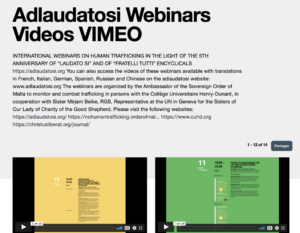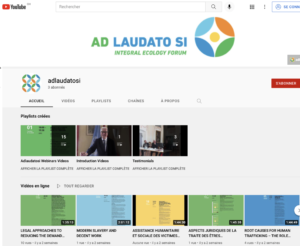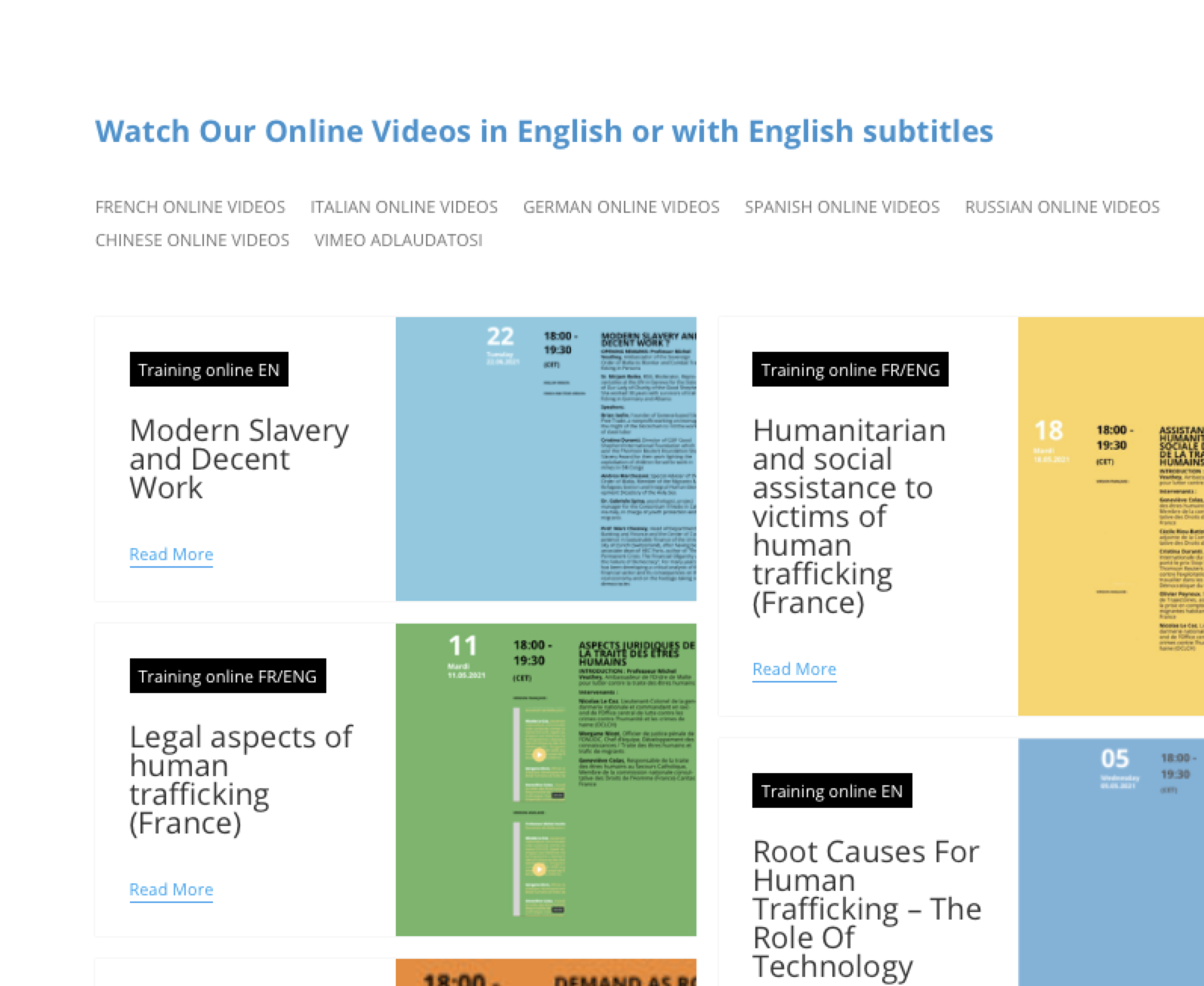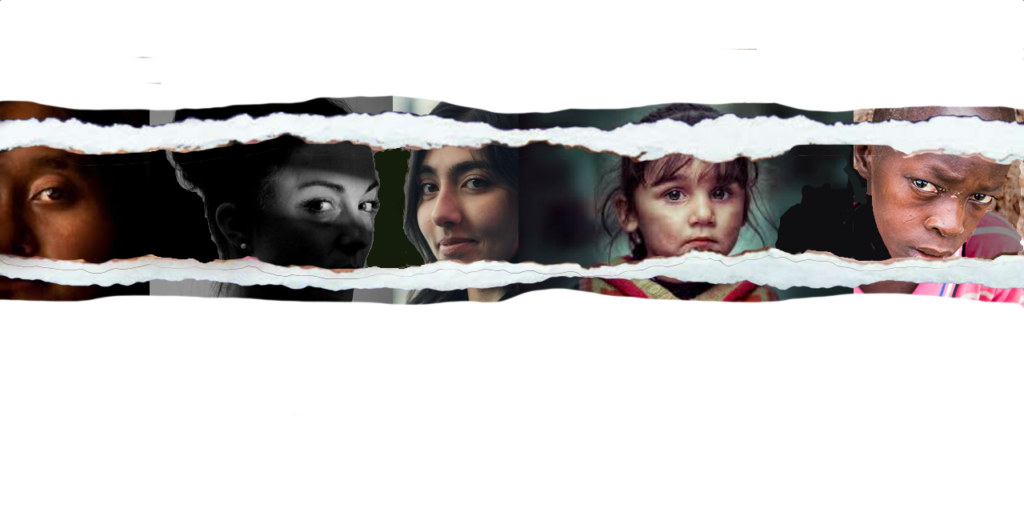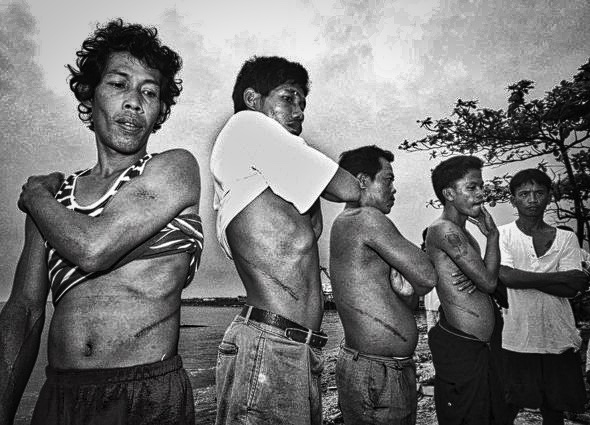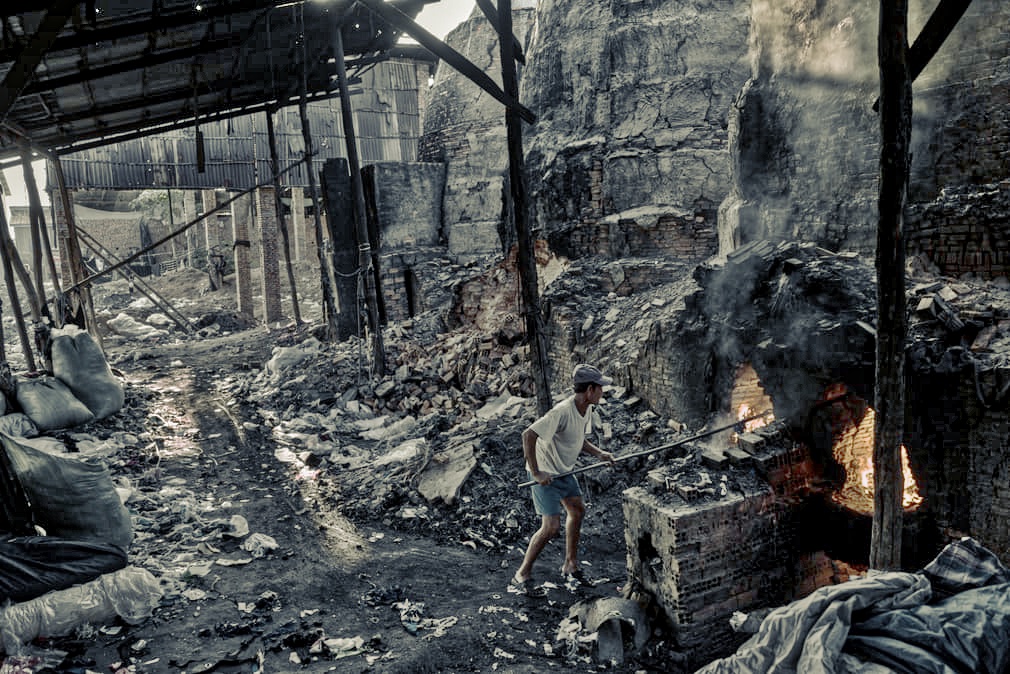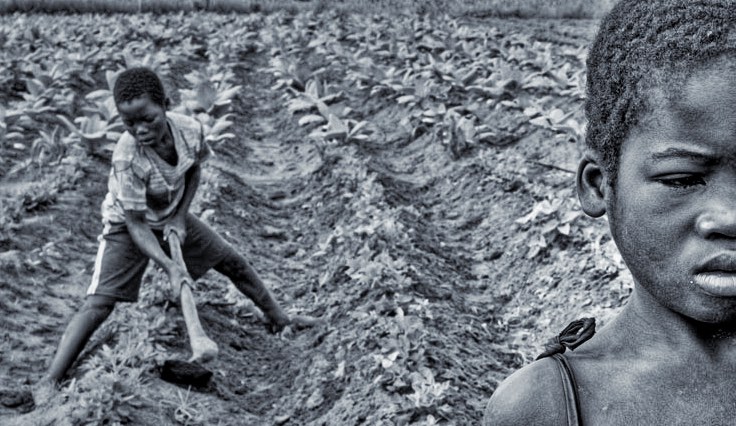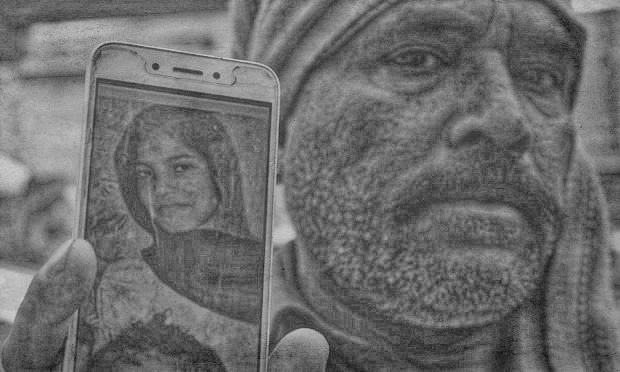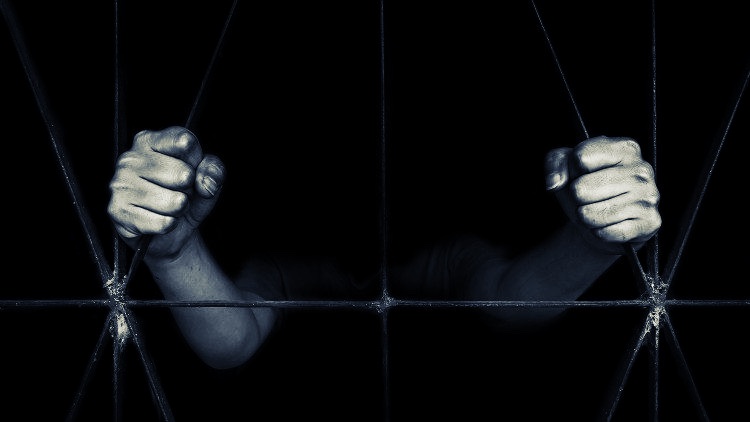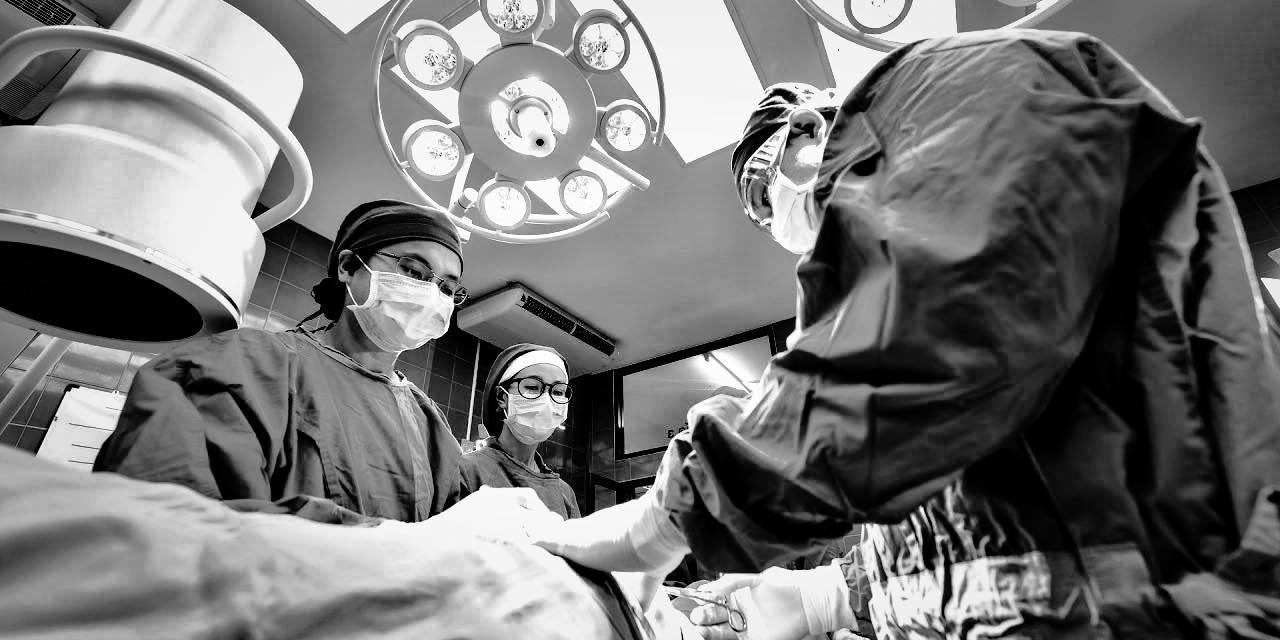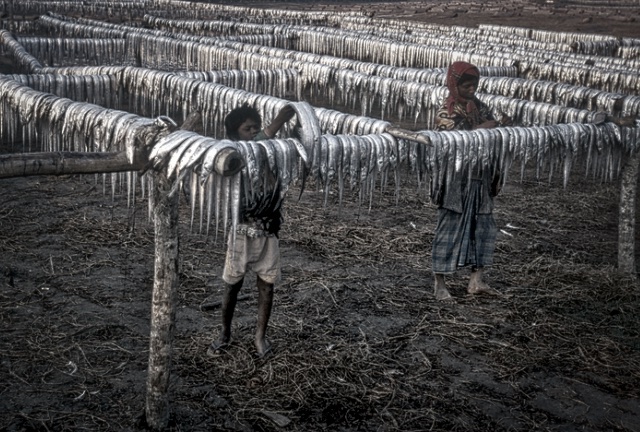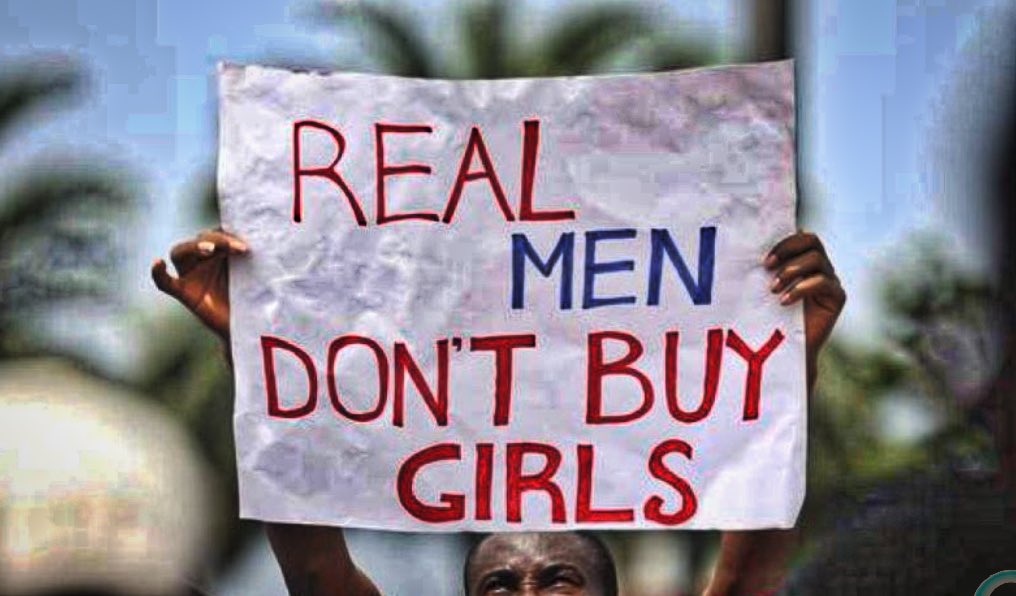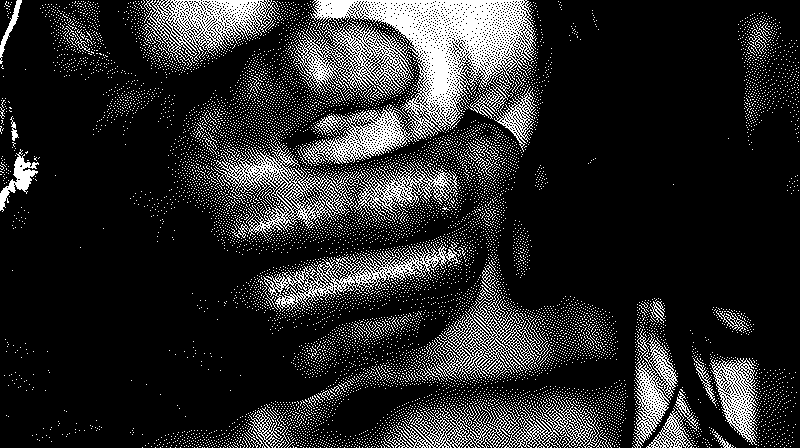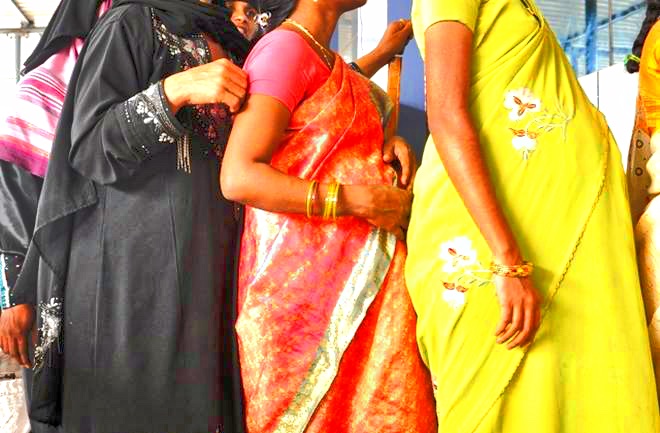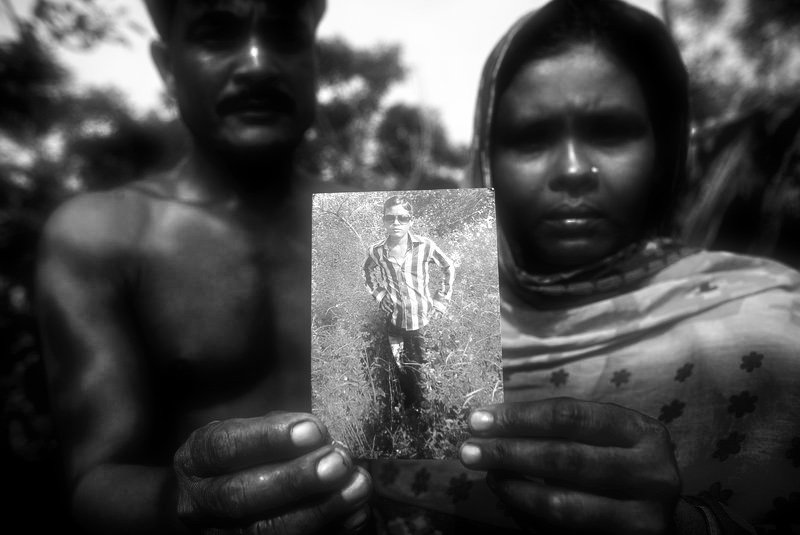Welcome to our free online training modules!Please select below the online course you wish to take…
All our on-demand video webinars are published on VIMEO and subtitled in 7 languages (English, French, Spanish, German, Italian, Chinese, Russian).
All our video-on-demand webinars are posted on YOUTUBE and subtitled in 7 languages (English, French, Spanish, Germanic, Italian, Chinese, Russian).


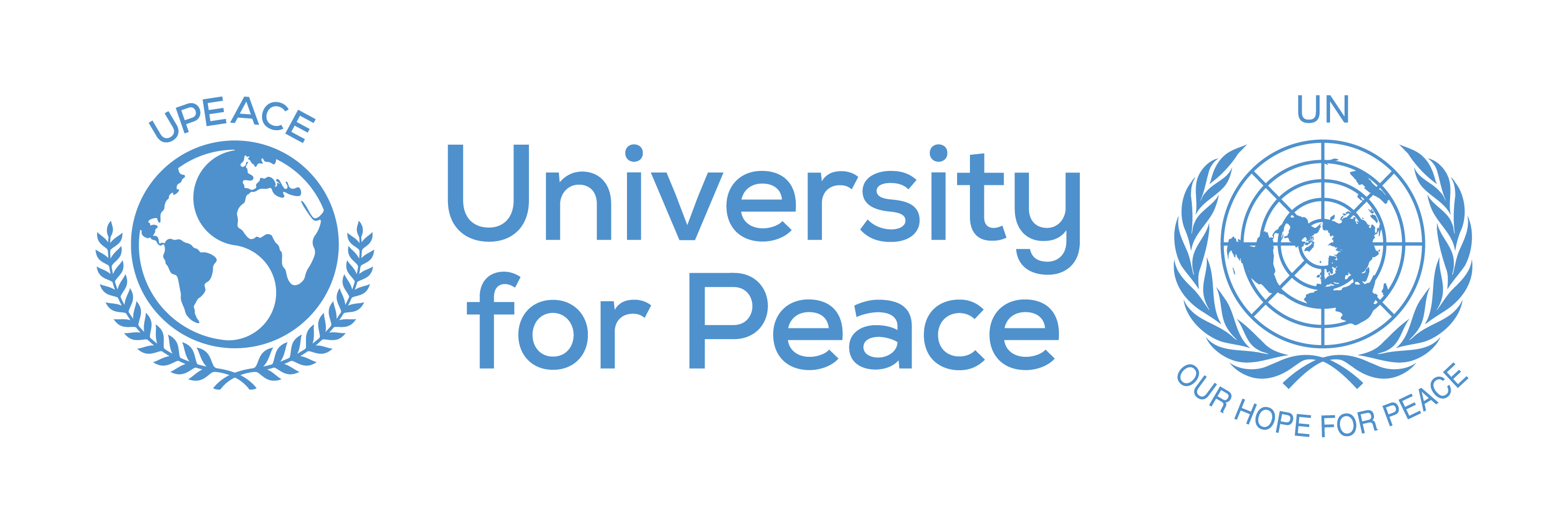
ONLINE COURSE LISTINGS
UNDERSTANDING, PREVENTING AND COMBATING TRAFFICKING IN PERSONS – AN ONLINE TRAINING COURSE
The online course “Understanding, preventing and combating human trafficking” is available in English. French, German, Italian, Spanish, and Portuguese will be available in the near future on our website www.cuhd.org.
Since the start of the course in 2020, 1,230 students have already registered.
The course is now regularly updated and developed in form and content with the help of academic partners.
We have designed this course to :
– Access videos and analysis from leading international anti-trafficking experts (list of experts available at www.adlaudatosi.org).
– Share best practices in combating and preventing human trafficking by sharing documents, videos and manuals on the protection, rehabilitation and reintegration of victims.
– Make available critical material for reflection and action developed by international organizations (UNODC, OHCHR, IOM, UNHCR, UNICEF), regional organizations (notably the Council of Europe and the European Union, as well as the OSCE), NGOs (notably ICMC), research and training centers, foundations, the media (ARTE, BBC, etc.), religious communities, notably the Catholic Church, not forgetting organizations run by survivors of this form of contemporary slavery.
We have illustrated the course with numerous videos, reports, guidelines, manuals and testimonials, to provide participants with the most recognized documents and data.
The interdisciplinary online course “Understanding, Preventing and Combating Human Trafficking – An Online Course” is designed to meet the expectations of an audience at different levels:
– People involved in and responsible for human trafficking projects,
– Experts looking for a veritable reference library on human trafficking, legislation and country action plans, guides and research on human trafficking by the main legal and operational actors,
– Anyone who wants to better understand human trafficking and help victims and survivors.
Participants will be able to navigate freely through the course and quickly find the topic that interests them.
The course will be free of charge, making it accessible to a wide audience.
PRESENTATION AND REASONS FOR TAKING THIS COURSE
Introductory video by Professor Michel Veuthey, President of CUHD.
Reasons to take this course
The online course “Understanding and combating human trafficking – A training course for caregivers” is designed to meet the expectations of an audience at different levels:
- people who are active and responsible for projects in the field of human trafficking,
- the experts in search of a veritable reference library on traffickingWe have compiled a wide range of documents, including country-specific legislation and action plans, guides and research on human trafficking from key legal and operational players,
- all those who wish to understand the problem of human trafficking.
This course aims to provide professional and practical tools to combat human trafficking and support victims. It does this by promoting three areas of action:
- Prevention conditions (poverty, inequality, family abuse) conducive to trafficking ;
- Assistance to victims and survivors by supporting their physical and psychological rehabilitation and helping with their social reintegration;
- Coordination of activities with existing support networks.
N avigate freely through the course and quickly reach the subject that interests you.
Accès to best practicesThe course can be used as a library to find documents, examples, etc.
Il is free of charge in order to the make accessibleto a public.
This course is designed to
- share best practices in combating and preventing human trafficking sharing documents, videos and manuals on the protection, rehabilitation and reintegration of victims, as well as on the psychological impact on caregivers (helping caregivers to avoid burnout and remain effective).
- provide important material for reflection and action developed by international organizations (UNODC, OHCHR, IOM, UNHCR, UNICEF), regional organizations (in particular the Council of Europe and the European Union, as well as the OSCE), NGOs (in particular ICMC), research and training centers, foundations, media (ARTE, BBC, etc.), religious communities (in particular the Catholic Church), not forgetting organizations run by survivors of this form of contemporary slavery.
The course is illustrated by a large number of videos, reports, guides, manuals and testimonials, providing you with the most recognized reports and data.
Access to course materials
Note that you can find the course material and its appendices by clicking on the Contents menu at the top of each chapter or lesson, as shown below:
Similarly, it is generally not possible to carry out surveys in countries with deep and ongoing conflicts, such as Syria, Iraq, Yemen, Libya, South Sudan and parts of Nigeria and Pakistan. Yet we know that conflict is a major risk factor – the breakdown of the rule of law, the loss of social support and the disruption that comes with conflict all increase the risk of forced labor and forced marriage. The lack of data from countries in conflict means that estimates of modern slavery in regions where countries are in conflict will underestimate the problem. The use of vulnerability data goes some way to mitigating the impact of this gap; however, the need for better data in conflict-affected countries remains an urgent research priority.
2010 Total estimate of slaves, in millions
2018 Total estimate of slaves, in millions
2018 Estimated total number of slaves in millions in Europe and Central Asia
2018 Estimated total number of slaves in millions in the Americas
2018 Estimated total number of slaves in millions in Asia and the Pacific
2018 Estimated total number of slaves in millions in Africa
2018 Estimated total number of slaves in millions in the Arab States
See above Note on DATA LIMITS – PREVALENCE
Today, slavery is developing at levels beyond what we have seen in previous centuries: in 2010, there were around 27 million slaves in the world. This figure represents double the number of all African slaves who were forced to emigrate from Africa to the Americas. In 2019, the latest estimates produced by international organizations put the number of people deprived of their freedom at over 45 million worldwide, with strong growth between 2010 and 2019. The profits from modern slavery worldwide, according to the same sources, exceed $150 billion.
Contemporary resurgence
Slavery has not disappeared. Despite being prohibited by a whole range of national and international legal instruments, slavery is on the rise throughout the world, including Europe, even if it is often invisible.
According to the Global Slavery Index (www.globalslaveryindex.org/findings), 58% of victims are found in the following 5 countries: India, China, Pakistan, Bangladesh and Uzbekistan. Women and girls account for 71% of slaves, or nearly 29 million people. One in four victims of modern slavery is a child, i.e. around 10 million people. In Europe, estimates put the figure at over a million, most of them from Romania, Bulgaria and Slovakia, as well as Nigeria, China and Brazil. Forced labor and sexual exploitation are the most widespread forms of slavery in Europe.
% of slavery victims in forced labor today
% of slavery victims in forced marriage today
% of victims in sexual slavery today
- In 2010, there were an estimated 27 million modern slaves in the world (twice as many as the African slaves forced to migrate to the Americas).
- In 2018, the latest estimates are over 45 million.
- Profits from modern slavery exceed $150 billion.
- In 2018, in Europe and Central Asia[1]according to the Global Slavery Index[2],the total number of victims of slavery was 3.6 million (including 1.3 million for the European Union).
- 58% of victims are in the following 5 countries: India, China, Pakistan, Bangladesh and Uzbekistan. Women and girls account for 71% of this total. One in four victims is a child. Forced labor and sexual exploitation are the most widespread forms of forced labor in Europe.
% of today's victims of slavery are women and girls
% of slavery victims today are men and boys
% of today's slaves are children under the age of 18
- It is assumed that one in four victims of contemporary forms of slavery in 2016 was a child. Women and girls were disproportionately affected, with over 71% of victims being female. Of the 24.9 million victims of forced labor, 4.1 million were subjected to forced labor imposed by the state, 4.8 million were victims of forced sexual exploitation of adults and/or commercial sexual exploitation of children, and 16 million experienced exploitation in the form of forced labor in the private economy. [3]
-
[1]51 countries: Turkmenistan, Belarus, the former Yugoslav Republic of Macedonia, Greece, Albania, Turkey, Ukraine, Croatia, Montenegro, Lithuania, Russian Federation, Republic of Moldova, Armenia, Uzbekistan, Tajikistan, Bulgaria, Azerbaijan, Georgia, Romania, Cyprus, Kazakhstan, Kyrgyzstan, Kosovo, Latvia, Israel, Hungary, Estonia, Bosnia-Herzegovina, Poland, Serbia, Slovakia, Czech Republic, Portugal, Italy, Spain, Slovenia, Iceland, United Kingdom, Germany, Belgium, France, Norway, Netherlands, Austria , Switzerland, Ireland, Finland, Denmark, Sweden, Luxembourg.
To help you better understand the size and scope of the problem,we’d like to mention the following:
Key points from the 2019 report of the UN Special Rapporteur on contemporary forms of slavery – (A/HRC/42/44)
THE REPORT ON CURRENT AND EMERGING FORMS OF SLAVERY BY THE SPECIAL RAPPORTEUR (MRS URMILA BHOOLA) TO THE HUMAN RIGHTS COUNCIL (SEPTEMBER 2019) STATES:
The future of work
- Vulnerability to slavery is closely linked to labor market regulations and dynamics.
- Clandestinity, including casualization, and other forms of job insecurity are risk factors for vulnerability to slavery.
- If technological and social changes in the world of work are not people-centered, and trends towards decent work deficits are not addressed22 , precariousness in labor markets could increase23 , with the added risk of slavery. Low-skilled jobs are likely to be affected by automation, which will put displaced workers in competition with other low-skilled workers, for fewer jobs and lower wages.
Demographic trends and migration
- Limited access to employment is also one of the main drivers of migration, itself a major source of vulnerability to slavery.
- Migration is likely to continue to increase due to triggers such as conflict, income inequality, lack of economic opportunity and climate change, and push factors such as demand for labor.
- Economic changes will also have an impact on the geography of slavery. Asia, already burdened by the highest absolute prevalence of slavery, according to Global Estimates, is experiencing an economic boom that could further increase the risk of slavery in certain economic sectors, notably construction and infrastructure development.
Environmental change
- The geography of contemporary forms of slavery will also be strongly affected by climate and environmental change.
- By 2050, around 5 billion people could be living in areas where the climate Climate change will “exceed historical limits of variability”(31) and 143 million people in sub-Saharan Africa, South Asia and Latin America will face internal migration due to climate change32 , increasing the vulnerability of these populations.
- There is also evidence of covariance between the likelihood of contemporary forms of slavery and the likelihood of laws violations of environmental and standards, whether in the fishing industry, forestry or agriculture.
Other emerging trends
- New technologies are leading to new forms of exploitation, such as forcing children to take part in online sexual exploitation.
- There are also worrying signs suggesting a resurgence of slavery in contexts of armed conflict, not only as a method of recruitment, but increasingly as an overt tactic of ideological subjugation and conflict financing.
- Conflict-induced displacement are at historically high levels, further limiting people’s access to decent work, disrupting social relations and increasing their vulnerability to debt bondage, forced labor, commercial sexual exploitation, child labor and servile forms of marriage as a means of survival and coping.
-
Finally, there will be an increased risk of forced and bonded marriage and sexual slavery in societies where there is a persistent imbalance between the sexes, a phenomenon that often results from the practice of sex-selective abortion.
Remedies
There is a general need for awareness-raising, information and training. A global effort at national, regional and international level is needed to remedy this total and massive denial of fundamental human rights.
In everyday reality, the victims of slavery living alongside us need structures for reception, protection and reintegration. The victims are invisible, unlike those of other periods in the history of slavery. This real invisibility means that our authorities and aid structures, whether public or private, are largely unaware of the problem.
The most urgent and necessary activity is to promote knowledge of the facts and methods behind the development of modern slavery. Governments and civil society must also take steps to help and rehabilitate the victims of this slavery. Finally, prevention through education and other economic, social and political measures that restore the rule of law are necessary to ensure the protection and rehabilitation of survivors and the prosecution of criminals.
END OF QUOTATIONS
—————————————————————————————————-
Course structure
The approach adopted in this course could be qualified as “holisticas it seeks to study trafficking in its entirety, taking into account the complexity of its implications. This approach analyzes relevant economic factors and migration policies, taking into account the profound changes in gender roles and relations. From this point of view, exploitation, sexual or otherwise, is at the heart of trafficking.
This course aims to provide readers with a professional and practical tool for combating trafficking and supporting victims. It does this by promoting the following three areas of action:
- Preventing conditions that encourage human trafficking (poverty, inequality, domestic violence);
- Help for victims, support for their physical and psychological rehabilitation and assistance with social reintegration;
- Coordination of activities with existing support networks.
The course explains the phenomenon of human trafficking and its corollaries, first defining the subject and then exploring its various implications. The main trafficking topics are divided into seven chapters, each presenting a basic explanation as a starting point for further exploration. Chapters 1 to 3 are closely linked to migration, so they begin with a discussion of migrants or migration before turning to trafficking itself and its victims.
The distribution of themes and the coherent layout of each chapter enable students to consult specific sections according to their interests or needs, as well as their level of knowledge.







